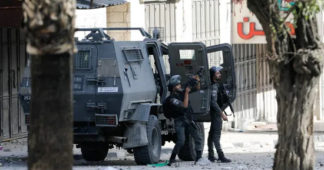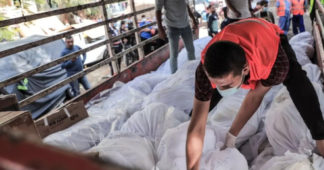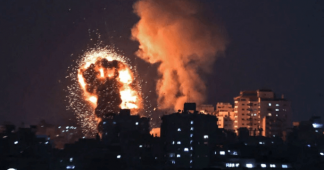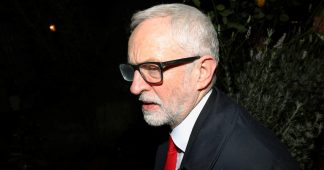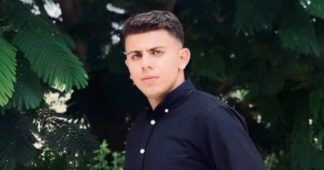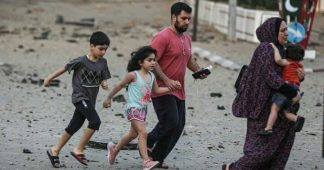A Jacobin investigation explores Israel’s practice of using the bodies of slain Palestinians as bargaining chips, refusing to return them to their families. Denying the right to bury loved ones, this policy inflicts the anguish of mourning without closure.
By Jaclynn Ashly
Nov 28, 2023
After Israeli forces shot and killed thirty-nine-year-old Fadi Samara in May of 2020, his mourning family dug him a grave in his village of Abu Qash, located in the occupied West Bank district of Ramallah.
But nearly four years later, his grave remains empty.
“I take the children to their father’s grave a few times a month even though we still have not received his body,” says Saja Muhammad, Samara’s thirty-one-year-old widow and mother to his five children, ages nine to three.
“It gives the children some comfort,” she continues, sitting on the couch at her family’s home in the city of Biddya in the northern Salfit district, where she returned following Samara’s killing. “We live with the hope that one day his body will be returned to us. And when that day comes his grave is ready to receive him.”
Samara’s body is one of hundreds currently held by Israel, part of a decades-long policy that researchers and rights groups describe as an attempt to control and punish Palestinian families by withholding the corpses of their slain loved ones. Some are buried in nameless graves and others are frozen in refrigerators.
Israeli officials claim this controversial practice is necessary to avoid incitement during funerals of Palestinians killed by Israelis. Israel also withholds the remains of slain Palestinians who are suspected of having carried out attacks against Israelis, using their corpses as bargaining chips for future negotiations with Palestinian leaders.
However, Palestinians, some of whom have waited for months, years, and in some cases decades for the return of their slain loved ones’ bodies, argue that this policy aims to punish them, condemning their lives to perpetual mourning.
Israel is the only country in the world that has a policy of confiscating and withholding human remains, which is a violation of international humanitarian and human rights law.
“This is all very hard,” Saja continues, her eyes blurring with tears. “My children ask me every day when they will be able to bury their father. It is hard to accept that he’s actually gone without the closure of burying him.”
The interviews in what follows were all conducted before the October 7 Hamas attack on southern Israel, which killed at least 1,200. Israel’s subsequent attacks on Gaza have resulted in more than 14,000 deaths, including 5,500 children. The director of Al-Shifa hospital, Gaza’s largest medical facility, recently besieged and raided by the Israeli army, claims that Israeli forces have forcibly taken and confiscated Palestinian bodies from morgues and streets, describing the remains as “kidnapped.”The overwhelming death toll in the Gaza Strip due to Israeli airstrikes has strained hospitals, morgues, and cemeteries, forcing Palestinians to bury their dead in mass graves, with many remaining unidentified.In light of this staggering violence, Israel’s refusal to repatriate the bodies of the slain has gained a renewed and grim significance.
Dwindling Hope
Palestinian families have consistently claimed that Israel has refused to release corpses to families, even when there is no evidence the slain person, such as Samara, was involved in an attack. At the time, the Israeli army asserted that Samara, who worked for years inside Israel in the city of Holon, was killed while attempting an attack on Israeli soldiers at a checkpoint near the village of Nabi Saleh, in the Ramallah district.Samara was killed shortly after Eid al-Fitr, the holiday following the Muslim holy month of Ramadan, while the family was still celebrating. The Palestinian Authority, which governs some parts of the West Bank, had lifted a months-long lockdown to curb the spread of the coronavirus, allowing Palestinians to visit their families. On this fateful summer day, Samara was driving through Ramallah, headed home to join his family, who were preparing a barbecue and awaiting his arrival.
But when he turned a corner, Samara unexpectedly drove into a confrontation between Israeli soldiers, strapped with machine guns, and rock-pelting Palestinians.Some witnesses say Samara tried to stop, causing the car to skid towards the middle of the road, which is when the soldiers began shooting. Others say that the soldiers shot him first and then his car swerved. The Israeli army claims that Samara had slammed on the gas and was speeding towards them, planning to run them over. However, Samara’s family maintains that he was not attempting an attack but was simply a bad driver.The soldiers fired at least ten bullets into Samara’s body.
“When Israel called him a terrorist to justify shooting him, it felt like they were killing him again,” Saja says. Her youngest son, who was just four months old when Samara was killed, sits quietly on a sofa chair across from her, listening. “My husband never had anything to do with politics. He had a permit to work inside Israel. If he really wanted to plan an attack, why wouldn’t he have carried it out in Israel? Why would he decide to do it here?”
Randa May Wahbe, an anthropologist and researcher at Harvard University, explains that a majority of the earliest cases of withholding Palestinian remains involved those who fled or were expelled from their homes during Israel’s establishment — a period known as the Nakba, or “catastrophe,” among Palestinians. After decades of exile in refugee camps in surrounding countries, the displaced attempted to return to Palestine. “They were killed on or near the borders,” Wahbe explains. “Eyewitnesses say they saw the Israeli army airlift their bodies and they were never to be seen again.”
“Cemeteries of Numbers”
In June of 1967, during the Third Arab-Israeli War, Israel occupied the West Bank, including East Jerusalem, and the Gaza Strip. In the wake of the violence, Israeli authorities interred slain Arab soldiers and prisoners of war in mass graves. Throughout the 1960s and 1970s, when the Palestinian resistance operated from Jordan, scores of Palestinian guerilla fighters were killed in clashes with Israeli soldiers after crossing the border. Issam Aruri, the director of the Jerusalem Legal Aid and Human Rights Center (JLAC), which has long worked to repatriate Palestinian remains, notes that many of these fighters did not possess identity documents.
They were buried in what are known as “cemeteries of numbers,” which are sites inside Israel, mostly located in closed military zones. These graves, devoid of names, are identified only by a number corresponding to a file for each deceased individual. According to Aruri, it is estimated that at least 254 Palestinians and other Arabs are believed to have been buried at these locations.Throughout the following decades, the Israeli army continued to bury the bodies of slain Palestinians at these sites or withheld the bodies until the families accepted various restrictions for the respective funerals. Israeli authorities argued that these funerals sparked large demonstrations that posed a threat to the state’s security.Israel’s decisions, however, were largely informal and made on a case-by-case basis, marked by arbitrariness. Sometimes, Israel refused to return bodies of Palestinians, while at other times, it would return some of them.
Bringing Back the Dead
In the mid-1990s, Israel finally took steps to formalize its approach to handling the remains of individuals who died as a result of conflict. However, it relied on regulations from 1945, during the British Mandate of 1920–1948, which permitted the army to keep bodies.From 2007 to 2015, Israel discontinued this practice. At that time, another Palestinian uprising, often referred to as the “knife intifada,” emerged. During this period, Palestinians sporadically and individually attacked military, police, and settlers with knives and makeshift weapons. As a result, hundreds of Palestinians were killed and their bodies were frequently confiscated from families.Since 2015, the bodies of these slain Palestinians have been held in refrigerators at the Abu Kabir Forensic Institute near Tel Aviv. The total now stands at 135, and the bodies that have been returned to families were subject to strict conditions. According to Aruri, twelve of the bodies remaining are of children under the age of eighteen.
In negotiating the return of their dead, families have been forced to provide monetary deposits to Israeli authorities as financial guarantees that they will adhere to posthumous restrictions. These restrictions have included commitments not to conduct an autopsy or admit the returned corpses to hospitals. Aruri says these stipulations are aimed at “preventing investigations on the circumstances of the assassinations.”
In some instances, families are told that their slain loved ones must be buried far away from their family homes. In 2018, the Israeli government, for the first time, passed a resolution which stated that the bodies of Palestinians associated with Hamas and Islamic Jihad, or those involved in particularly dramatic attacks against Israelis, should be withheld.
According to Israeli rights group B’Tselem, holding the bodies of Palestinians as bargaining chips for future negotiations is a longstanding practice in Israel. But the policy has always been vague, with decisions “made in every case separately and on an ad-hoc basis in response to pressure put on the establishment and according to political considerations.”
Prisoner Swaps
In response to the October 7 Hamas attack, Israel has retaliated by conducting devastating air raids on the besieged territory of Gaza, targeting residential buildings, hospitals, refugee camps, and schools — and launching a ground invasion. This has resulted in the bloodiest massacre in Palestine’s history.More than two hundred Israelis and some foreigners were taken hostage during Hamas’s attack and are being held captive in the Gaza Strip. However, Abu Obeida, the spokesperson of Hamas’s military wing, the Qassem Brigades, reports that at least 60 hostages have been killed in the Israeli airstrikes.Before the unprecedented attack by Hamas, Saja, along with other families of slain Palestinians whose bodies are withheld by Israel, expressed her dwindling hope that Israel would return Samara’s body to the family. “Our only hope is that Israel agrees to an exchange of prisoners with Hamas and they include the dead bodies in the deal,” she said. “But I can’t imagine that will happen any time soon.”
Little did she know that a few months later, the world would watch as Hamas breached Israel’s “iron wall,” which separates the besieged enclave from Israel and is equipped with hundreds of cameras, radars, and sensors. This marked the beginning of a massive, complex attack on Israel that resulted in hundreds being taken hostage. While the world reacted with shock, Palestinian families with loved ones who are incarcerated in Israeli prisons or whose bodies are retained in an Israeli mortuary saw a glimmer of hope that their family members, whether alive or dead, would be returned to them.Hamas has demanded that Israel release 5,200 Palestinian political prisoners currently incarcerated in Israeli prisons, a practice that violates international law. This demand is in exchange for the hostages — an option supported by many families of the hostages. Israel has agreed to such deals before, notably in 2011 when Hamas released Gilad Shalit, an Israeli soldier, in exchange for the release of 1,027 prisoners. Israeli forces, however, later rearrested many of them. Last Wednesday, Israel and Hamas agreed to a four-day truce, which includes the return of fifty women and children held hostage by Hamas in exchange for Israel releasing 150 Palestinian women and children from its prisons.According to Wahbe, since the 1970s, Israel has released about 7,500 Palestinian prisoners through prisoner swaps.
“Historically, prisoner swaps have proven to be the only viable option to release Palestinian political prisoners in large numbers, which is a large part of why Palestinian families put their faith in this option,” Wahbe tells me.
Mass Graves
In November 2021, a photo circulated on social media showing a mutilated corpse. This body had been returned to the family of Amjad Abu Sultan, a fourteen-year-old who was killed by Israeli forces about a month earlier. When the family unzipped the plastic body bag, they realized that the disfigured body lying before them was not their son.The photo made its way to Samara’s family. “My whole soul fell to the ground when I saw that picture,” Saja says, bringing the photo up on her mobile phone, showing a grisly and swollen corpse. “I knew immediately that this was Fadi [Samara].”She breaks down in tears and puts the phone down. “Because we had never seen his body, there was always a hope that maybe he was not actually killed. When I saw that picture, it felt like he was being killed again — it was as if the Israelis were not satisfied with killing him once. They murdered him again and again.”
Abu Sultan’s family eventually received their son’s body, but Israeli authorities transported Samara’s body back to Tel Aviv and returned it to the refrigerator at the morgue. Since then, there has been no progress in repatriating Samara’s remains, Aruri says. Notably, Israeli authorities have not officially concluded that Samara had affiliations with Hamas or Islamic Jihad, and he had not committed any serious act against Israelis.The Israeli army’s mix-up of dead Palestinian bodies is not unique to Samara’s case. Israel has transferred the wrong body to Palestinian families on multiple other occasions and has a history of neglecting Palestinian corpses.In response to a rare legal case which sought to locate the remains of two Palestinian missing persons, the Israeli military released a special report in 1999. This report revealed that corpses of Palestinians were handled negligently, buried in shallow graves, described as “a single ‘trench’ without a layer of dirt separating the tombs.” Wahbe notes that this phrasing refers to mass graves.
“Cow dung littered the cemetery, suggesting that it had been used as an animal grazing ground, and erosion and negligence had made it impossible to find or identify the remains,” Wahbe states. “Such negligence and disregard for the sanctity of the dead has been interpreted by the families as an indication that the Israelis had no intention of ever identifying or returning the bodies.”
Harvesting Organs
Throughout JLAC’s years-long investigations into Palestinian remains held by Israel, discrepancies were discovered in the numbering system at the “cemetery of numbers.” The numbers, ostensibly indicating the identity — if known — of the individual buried there, did not align with DNA samples taken from the human remains. In some instances, bodies were mixed together, and at times, they were missing entirely.“[Israeli authorities] found that many of these graves are empty and in others there are mixed parts of different individuals,” Aruri explains. “And, still, in other cases they told us officially that they did not find the body. They confessed that [the body], according to their system, was supposed to be there, but it’s not there.”The absence of these bodies supports long-standing reports that Palestinian corpses may have been used for organ harvesting or donated to Israeli medical schools for students to train on the bodies, Aruri says. In the early aughts, the Israeli military acknowledged the existence of such a program after Dr. Yehuda Hiss, former head of the Abu Kabir Forensic Institute, admitted that the army had harvested skin, corneas, heart valves, and bones from the bodies of Israeli soldiers, Israeli citizens, Palestinians, and foreign workers during the 1990s. The practice often occurred without the consent of the deceased’s relatives.
“This would explain why there are bodies that the army admits they once had, but now claims to have lost track of,” Aruri says. Palestinians have also claimed that the bodies of young men who were seized from the occupied West Bank and Gaza Strip were returned to their families with missing organs.
However, even for families who manage to locate and repatriate their slain loved ones, the corpses are often returned in a dismal state.
“The Israelis keep them frozen, in temperatures below -60 degrees Celsius,” Aruri tells me. “When the families receive the bodies, sometimes they are like ice blocks and they need to allow them to melt. And that freezing has a similar effect as burns, so some families can barely recognize their faces once the bodies have been thawed out.”The body of Bahaa Elayyan, a twenty-two-year-old resident of the occupied East Jerusalem neighborhood of Jabal al-Mukabbir, was released to his family in 2016, 325 days after he was killed. This occurred following an attack on an Israeli bus in 2015, where Bahaa and another Palestinian killed three Israelis.The body’s release was only greenlit after the family agreed to bury him in a cemetery chosen by the Israeli police. Only twenty-five people were allowed to attend the funeral. The family also had to pay a 20,000 Israeli shekel ($5,292) deposit to ensure compliance with these regulations.
At the time, Bahaa’s father, Muhammad Elayyan, said that his son’s body was severely disfigured from the many months he spent frozen in the morgue. “His eyes sank inside his skull as if he did not have any, muscles atrophied, and his skin peeled off easily,” Muhammad said at the time. “It was difficult to identify him, except that I am his father and I know him well.”
Detained After Death
Deprived of the opportunity to organize a funeral or burial and denied a death certificate, many Palestinian families have been unable to process the death of their relatives. “The whole process of burial and receiving condolences from people is part of the healing process,” Aruri says. “If families aren’t able to bury the body — or even see it — and they can’t hold a funeral, then deep inside they believe their loved ones are still alive.”In the aftermath of killings, Palestinian families experience various forms of punishment. Parents and relatives face arrests and interrogations, with Israeli forces routinely conducting nighttime raids on their homes. Work permits are revoked and travel bans are enforced by Israeli authorities. Israel also often demolishes their homes.Families of the deceased also grapple with a range of legal complexities. Without a death certificate, widows are unable to move on with their lives and marry again. If their slain husbands managed the family’s bank account, it becomes frozen, leaving widows without access to funds, while inheritance rights are also denied.
According to Wahbe, the withholding of Palestinian bodies plays an “important role in allowing the Zionist colonial state to demonstrate its power.” The “denial of dignity to the dead” is a way that Israel “asserts control over the living family.”“Palestinians are already dehumanized in life through a matrix of Israeli colonial domination that controls each aspect of Palestinian existence,” says Wahbe. “At the heart of this structure are Israel’s mass incarceration practices that have subjected over 20 percent of the Palestinian population to arrest by criminalizing any form of resistance to colonial control.”“This postmortem imprisonment of bodies has been understood by Palestinians as being criminalized beyond death,” she adds. Palestinians often refer to these dead bodies held by Israel as “detained martyrs,” or “martyr prisoners,” Wahbe explains, underscoring the extension of Israel’s detention policies “into the realm of death.”
“Never Forget”
Ghazi Sharqawi’s family’s history is typical of many Palestinians. Hailing from Kafr ‘Ana, a Palestinian town located eleven kilometers east of Jaffa and now part of the state of Israel, his family faced expulsion by Zionist forces. The Alexandroni Brigade, implicated in the Tantura massacre, expelled all of the village’s inhabitants during the creation of Israel in 1948. This displacement resulted in the repurposing of the village’s lands for the settlement of Jewish immigrants.The family eventually found themselves in the Amari refugee camp in Ramallah, where they still reside. Ghazi, sixty-four, grips a framed photograph in his hands; it is the only one the family has of Samih Sharqawi, Ghazi’s uncle. The memory of Sharqawi echoes through multiple generations, as the family persists in their quest, spanning more than half a century, to locate his body.
Sharqawi, born in 1949, a year after the Nakba, was killed by Israeli forces in 1968. This was one year after the Naksa, an Arabic word meaning setback or defeat, that refers to the 1967 war, when Israel annexed the whole of historic Palestine.At the outbreak of the 1967 war, Sharqawi, then about nineteen, traveled to Jordan to join the Palestinian resistance. According to Ghazi, Sharqawi participated in a number of military operations against Israel, crossing the border and attacking Israeli targets in the Jordan Valley. The final incursion resulted in Sharqawi, along with two other fighters, being killed by an Israeli bomb. Another of the fighters, injured but able to escape back to Jordan, informed Sharqawi’s family about his death.“But this person who escaped did not check their bodies to confirm they were actually dead,” says Ghazi, who is Sharqawi’s nephew. Ghazi was about ten years old when Sharqawi was killed. “So our parents always thought that one day they might find him in an Israeli prison. They never believed he was actually dead.”
For decades, Ghazi’s grandparents — Sharqawi’s parents — and his father — Sharqawi’s brother — tirelessly searched for him, both in prisons and among the graves. They believe his remains were eventually buried in the “cemeteries of numbers.” But, to this day, they have not been able to track him down.
“My parents were sad all the time when I was growing up,” Ghazi remembers. “They didn’t even have a photo of him. He didn’t have any children before he was killed so there were no physical remnants of his life.”
But in 1994, Ghazi’s cousin traveled to Iraq to further his studies and visited the Palestine Liberation Organization (PLO) office there, where he found a photo of Sharqawi, which now hangs on the walls of the family’s home in the refugee camp.
“I will never forget my father’s reaction when he saw that photo for the first time,” Ghazi tells me. “He cried a lot. It was the first time he had received evidence that his brother had ever existed.”
Erasing the Right To Exist
According to Aruri, JLAC is aware of seventy-six cases of Palestinian missing persons in which families are uncertain about the fate of their loved ones — not even sure whether they are alive or dead. However, he notes that this number is likely “much higher.”Israel’s policies, whether enforced on the living or the dead, have a single goal: “eliminate Palestinians from their homeland,” Wahbe says. “For Palestinians, cemeteries are sacred spaces that are not only a place to mourn the dead, but also a record of generational and geographic history and belonging.”Israel, in addition to denying Palestinians the rights of burial, has desecrated historic Palestinian cemeteries. This includes the bulldozing of the centuries-old Mamilla Cemetery in Jerusalem, which held the remains of companions of the Prophet Muhammad and thousands of Christians from the pre-Islamic era and the crusader period.
Starting in 2008, excavation crews removed about one thousand skeletal remains from the cemetery, replacing it with a Museum of Tolerance. This museum commemorates the Jewish Shoah, meaning “catastrophe,” referring to the Holocaust, where nearly six million Jews in Europe were killed by Nazi Germany and its collaborators.
This process, according to Wahbe, reflects the state’s “insistence on not only altering the identity of the space and claiming sovereignty over it in the present, but also enacting an erasure of any non-Israeli past.” She adds, “The construction of the Museum of Tolerance over desecrated tombs is an attempt to transform the identity and meaning of the land from Palestinian to Jewish.”
“Violently destroying sacred sites and replacing them with national markers is a loud pronouncement that Palestinian bodies, even in death, are not allowed on this land,” Wahbe asserts. She explains that disappearing Palestinian bodies or withholding them from their families is an extension of this erasure of Palestinians and their “indigenous presence and right to existence.”
For Sharqawi’s family, their quest to find his body persists — an attempt to reclaim a right they feel Israel stole from them. “I have seven children and eleven grandchildren,” Ghazi says. “And each one of them has a photo of Sharqawi. I make sure to always talk about him and to build his memory into the next generations so that they will grow up and continue the search for him.”
“We won’t stop until we find him, even if it takes one hundred years,” he adds. “This family will never forget, and we will never forgive.”
We remind our readers that publication of articles on our site does not mean that we agree with what is written. Our policy is to publish anything which we consider of interest, so as to assist our readers in forming their opinions. Sometimes we even publish articles with which we totally disagree, since we believe it is important for our readers to be informed on as wide a spectrum of views as possible.
